Are you or someone you know struggling with reading, writing, and spelling? Do you find it difficult to process and understand written information? These could be signs of dyslexia, a common learning disorder that affects millions of people worldwide. If you suspect you or a loved one may have dyslexia, it is important to know how to get tested for dyslexia.
Misunderstanding and misdiagnosing dyslexia are common, but individuals with dyslexia can thrive academically and personally with the right support and intervention. The first step to overcoming dyslexia is to get tested for it.
Understanding Dyslexia
Before we dive into the testing process, let’s first understand what dyslexia is. Dyslexia is a neurological disorder that affects the way the brain processes written language. Individuals with dyslexia have difficulty with reading, writing, and spelling, despite having normal intelligence and education.
Dyslexia is not a sign of laziness, low intelligence, or a lack of motivation. It is a specific learning challenge that affects individuals differently. Dyslexia can impact one’s academic and personal life, but with early intervention and support, individuals with dyslexia can overcome these challenges.
Signs of Dyslexia
Dyslexia can manifest in many ways, but some common signs include:
- Difficulty with phonemic awareness (the ability to recognize and manipulate sounds in words)
- Struggling with reading fluency and accuracy
- Difficulty with spelling and writing
- Struggling to understand written instructions or information
- Difficulty with time management and organization
- Low self-esteem and frustration with academic tasks
If you or someone you know is experiencing any of these signs, it may be time to get tested for dyslexia.
Getting Tested for Dyslexia
The testing process for dyslexia involves a comprehensive evaluation of an individual’s academic, cognitive, and language abilities. The goal of the assessment is to identify any learning challenges and determine if dyslexia is present.
Here is a step-by-step guide on how to get tested for dyslexia:
Talk to a Professional
The first step towards getting tested for dyslexia is to talk to a professional. This could be a school psychologist, special education teacher, speech-language pathologist, or educational therapist. These professionals are trained to identify and support individuals with learning challenges, including dyslexia.
Gather Information
Before the assessment, it’s important to gather information about the individual’s educational and medical history. This includes any previous assessments, school reports, and medical records. This information can help the assessor gain a better understanding of the individual’s strengths and weaknesses.
Comprehensive Assessment
The assessment for dyslexia typically includes a comprehensive evaluation of the following areas:
- Cognitive abilities (IQ)
- Language skills (expressive and receptive language)
- Phonological awareness (ability to manipulate sounds in words)
- Reading skills (fluency, accuracy, comprehension)
- Writing skills (spelling, grammar, punctuation)
- Memory and processing speed
The assessment can take several hours, and it’s important to take breaks as needed.
Assessment Results
Once the assessment is complete, the assessor will review the results and provide a diagnosis if dyslexia is present. The assessment report will also include recommendations for support and intervention, such as accommodations in the classroom, tutoring, or specialized instruction.
Support and Intervention
After the assessment, it’s important to seek support and intervention for dyslexia. This could include working with a tutor, enrolling in a specialized program, or receiving accommodations in the classroom.
Transitioning into a Supportive Environment
The process of getting tested for dyslexia can be overwhelming, but it’s important to remember that a dyslexia diagnosis is not a limitation. With early intervention and support, individuals with dyslexia can thrive academically and personally.
It’s important to find a supportive environment that understands dyslexia and provides the necessary accommodations and resources. This could include working with a school psychologist, special education teacher, or educational therapist who specializes in dyslexia. It’s also important to talk to teachers and administrators about accommodations in the classroom, such as extended time on assignments, audiobooks, and assistive technology.
Self-Care and Empowerment
In addition to seeking support and intervention, it’s important to prioritize self-care and empowerment. Dyslexia can often lead to feelings of frustration, low self-esteem, and anxiety. It’s important to find activities and hobbies that bring joy and build self-confidence.
There are also many dyslexia advocacy groups and organizations that provide support and resources for individuals with dyslexia and their families. These organizations can provide information on dyslexia, support groups, and advocacy initiatives.
Conclusion
Taking the step to get tested for dyslexia is important in order to understand and overcome learning challenges. It’s important to talk to a professional, gather information, undergo a comprehensive assessment, and seek support and intervention. With the right support and intervention, individuals with dyslexia can thrive academically and personally.
Remember to prioritize self-care and empowerment, and find a supportive environment that understands dyslexia and provides the necessary accommodations and resources. Dyslexia does not define an individual, and with early intervention and support, individuals with dyslexia can reach their full potential.

